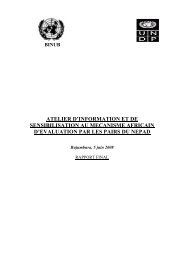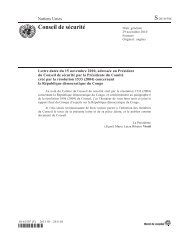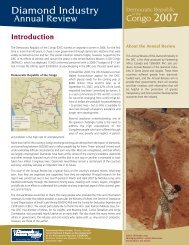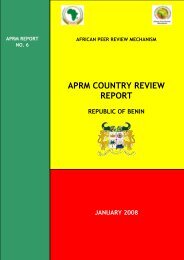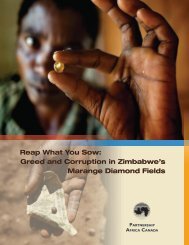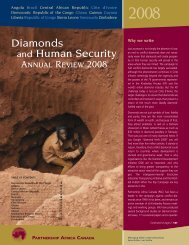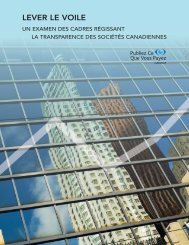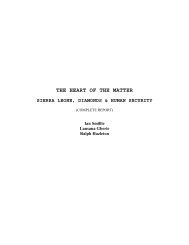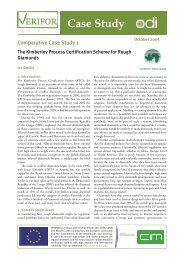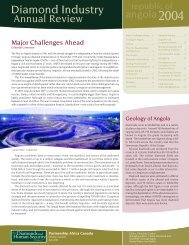Angola 2007 - Diamond Development Initiative
Angola 2007 - Diamond Development Initiative
Angola 2007 - Diamond Development Initiative
- No tags were found...
Create successful ePaper yourself
Turn your PDF publications into a flip-book with our unique Google optimized e-Paper software.
Republicof<strong>Angola</strong> <strong>2007</strong>The oblique track described by <strong>Angola</strong>’s Kimberlite deposits also coincideswith the division between the country’s two major watersheds. Below thisline, the rivers flow south – the Okavango and Zambezi systems. Abovethe line, the rivers flow north to join the Congo. Over the eons bothnorthward and southward flowing streams have worked away at primaryKimberlite extrusions, creating extensive alluvial and river-bottomdeposits to the south in Moxico, Cunene and Cuando Cubangoprovinces, and to the north near rivers in Bié, Malange, Uige, and especiallyin the provinces of Lunda Norte and Lunda Sul.A 2000 estimate put <strong>Angola</strong>’s total alluvial reserves at 40 million carats,while suggesting that these reserves would soon be exhausted. However,as older deposits in the Lundas have come under intense exploitation, thegarimpeiros forced off these sites have moved on and discovered newdeposits, either in the Lundas or in less traditional diamond provincessuch as Bié and Moxico. Production from the informal sector hasremained steady at just over a million carats per year, even as garimpeirosare forced far from their traditional diggings. <strong>Angola</strong>’s alluvial deposits,though undoubtedly finite, are likely much more extensive than previouslythought.The <strong>Angola</strong>n<strong>Diamond</strong> Industry:The Formal SectorThe Legislative Environment<strong>Angola</strong>’s current diamond mining legislation dates from the early 1990s,at the end of the first phase of the civil war, when both sides had temporarilyput down their weapons and the government was shifting theeconomy over to something approaching market capitalism.The <strong>Diamond</strong> Law, the backbone of <strong>Angola</strong>’s current diamond system,was promulgated in October, 1994. (Law No 16/94 of 7 October). In thetwo previous years a small flood of garimpeiros had poured into the diamond-bearingLundas. The government’s unease at this miniature WildWest shines through in the new law’s wording. The <strong>Diamond</strong> Law wouldcorrect ‘the idea that any citizen can appropriate a treasure that in constitutionalterms belongs to the State’, as well as squelch ‘the false ideathat the circulation of people and goods throughout the nation is entirelyfree, and not subject to restrictions and conditionalities.’The <strong>Diamond</strong> Law granted the ‘exclusive right to prospect, research,reconnoitre, exploit, handle and commercialize diamonds in all of<strong>Angola</strong>’s national territory’ to Endiama (the Empresa Nacional deDiamantes de <strong>Angola</strong>). Endiama could delegate these rights, but only toa public-private joint venture, in which Endiama itself held either an outrightmajority, or at least a plurality of ownership shares.The independent buying posts permitted under a 1991 law were closed,and Endiama was charged with taking over buying and selling diamondsthroughout <strong>Angola</strong>. Unauthorized prospecting, mining, transportation oreven simple possession of uncut diamonds were all punishable by prisonterms of 8-12 years. Informants were promised 25% of the value of anydiamonds seized.Artisanal diggers were to be permitted only in designated areas wheremechanized mining was not viable, and only provided they obtained anartisanal license. Prospective garimpeiros would have to be 18 years orolder, in possession of a valid identity documents, and resident for at leastten years in a county adjacent to the designated garimpeiro area. Theconditions were sufficiently onerous to scuttle the system from the outset.No licenses were ever issued, and no artisanal areas were ever designated.To restrict the movement of people and goods in the diamond bearingprovinces, the <strong>Diamond</strong> Law created three new legal jurisdictions: restrictedzones, protected zones, and reserve zones. Restricted zones are effectivelythe same as mining concessions. Access is strictly limited to thosedirectly involved with the production of diamonds. Goods can enter andleave a restricted zone only with the permission of the concession holder.Protected zones are buffer areas, surrounding restricted zones for fivekilometres in every direction. Ordinary members of the public are allowedto transit protected zones on public roadways, but they must carry ID anda letter of permission from their employer or local authority, and they andtheir goods are subject to inspection by the concession holder. No oneunconnected with the production of diamonds is allowed to live inrestricted or protected zones.3



